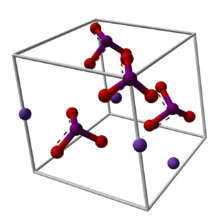Potassium iodate
Chemical compound From Wikipedia, the free encyclopedia
Potassium iodate (KIO3) is an ionic inorganic compound with the formula KIO3. It is a white salt that is soluble in water.[1]
 | |
 | |
| Names | |
|---|---|
| IUPAC name
Potassium iodate | |
| Other names
Iodic acid, potassium salt | |
| Identifiers | |
3D model (JSmol) |
|
| ChemSpider | |
| DrugBank | |
| ECHA InfoCard | 100.028.938 |
| EC Number |
|
| E number | E917 (glazing agents, ...) |
PubChem CID |
|
| RTECS number |
|
| UNII | |
CompTox Dashboard (EPA) |
|
| |
| |
| Properties | |
| KIO3 | |
| Molar mass | 214.001 g/mol |
| Appearance | white crystalline powder |
| Odor | odorless |
| Density | 3.89 g/cm3 |
| Melting point | 560 °C (1,040 °F; 833 K) (decomposes) |
| 4.74 g/100 mL (0 °C) 9.16 g/100 mL (25 °C) 32.3 g/100 mL (100 °C) | |
| Solubility | soluble in KI solution insoluble in alcohol, liquid ammonia, nitric acid |
| −63.1·10−6 cm3/mol | |
| Hazards | |
| GHS labelling: | |
   | |
| H272, H302, H318 | |
| P210, P280, P301+P312+P330, P305+P351+P338+P310 | |
| NFPA 704 (fire diamond) | |
| Flash point | Non-flammable |
| Related compounds | |
Other anions |
Potassium chlorate Potassium bromate |
Other cations |
Sodium iodate |
Related compounds |
Potassium iodide Potassium periodate |
Except where otherwise noted, data are given for materials in their standard state (at 25 °C [77 °F], 100 kPa).
| |
Preparation and properties
It can be prepared by reacting a potassium-containing base such as potassium hydroxide with iodic acid, for example:[1]
It can also be prepared by adding iodine to a hot, concentrated solution of potassium hydroxide:[1]
Or by fusing potassium iodide with potassium chlorate, bromate or perchlorate, the melt is extracted with water and potassium iodate is isolated from the solution by crystallization:[2]
- KI + KClO3 → KIO3 + KCl
The analogous reaction with potassium hypochlorite is also possible:[3]
KI + 3KOCl → 3KCl + KIO3
Conditions/substances to avoid include: heat, shock, friction,[4] combustible materials,[1] reducing materials, aluminium,[4] organic compounds,[1] carbon, hydrogen peroxide and sulfides.[4]
Applications
Summarize
Perspective
Potassium iodate is sometimes used for iodination of table salt to prevent iodine deficiency. In the US, iodized salt contains antioxidants, because atmospheric oxygen can oxidize wet iodide to iodine; other countries simply use potassium iodate instead.[5] Salt mixed with ferrous fumarate and potassium iodate, "double fortified salt", are used to address both iron and iodine deficiencies.[6] Potassium iodate is also used to provide iodine in some baby formula.[7]
Like potassium bromate, potassium iodate is occasionally used as a maturing agent in baking.[8]
Radiation protection

Potassium iodate may be used to protect against accumulation of radioactive iodine in the thyroid by saturating the body with a stable source of iodine prior to exposure.[9] Approved by the World Health Organization for radiation protection, potassium iodate (KIO3) is an alternative to potassium iodide (KI), which has poor shelf life in hot and humid climates.[10] The UK, Singapore, United Arab Emirates, and the U.S. states Idaho and Utah all maintain potassium iodate tablets towards this end.[citation needed] Following the September 11 attacks, the government of Ireland issued potassium iodate tablets to all households for a similar purpose.[11]
| Age | KI in mg | KIO3 in mg |
|---|---|---|
| Over 12 years old | 130 | 170 |
| 3 – 12 years old | 65 | 85 |
| 1 – 36 months old | 32 | 42 |
| < 1 month old | 16 | 21 |
Potassium iodate is not approved by the U.S. Food and Drug Administration (FDA) for use as a thyroid blocker, and the FDA has taken action against US websites that promote this use.[13][14]
Safety
Potassium iodate is an oxidizing agent and as such it can form explosive mixtures when combined with organic compounds.[1]
References
Wikiwand - on
Seamless Wikipedia browsing. On steroids.

